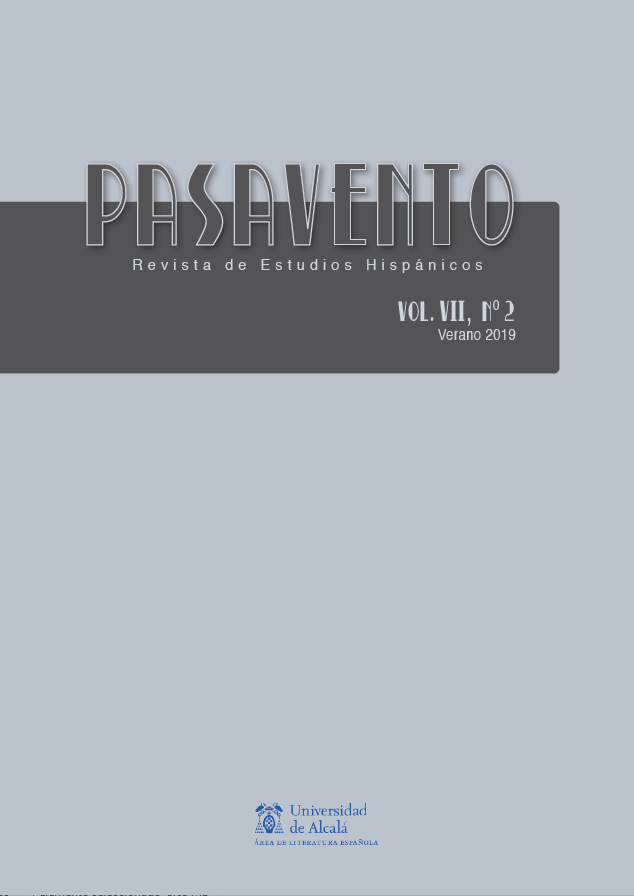“A Big Prehistoric Monster inside the Body”. The Portrayal of Aging in Samanta Schweblin’s “La respiración cavernaria”
DOI:
https://doi.org/10.37536/preh.2019.7.2.736Keywords:
Samanta Schweblin, Argentine Literature, Contemporary Short Story, Aging Studies, Latin-American LiteratureAbstract
This article examines Samanta Schweblin’s short story “La respiración cavernaria” in light of aging studies in literature. I argue that the portrayal of the protagonist’s aging process questions the normative codes that prevail in the social construct of old age. I propose Schweblin’s story as a theorizing fictional account of aging, based on Amelia DeFalco’s thesis in her book Uncanny Subjects: Aging in Contemporary Narrative. The story captures its protagonist’s memory loss through the layout of the domestic space and the objects that fill it, as well as through the deficient narration and some literary figures that echo those used in fantastic literature. Aging also entails an affective cost, which is why I draw from Sara Ahmed’s ideas in her book La política cultural de las emociones to explore the link between old age and shame. Schweblin’s story shows a protagonist who slowly loses her ability to narrate and instead clings to affective bonds that give her continuity in her identity. In this way, the story explores the unstable relationship between the construction of identity and narrative ability.
References
Ahmed, Sara (2015): La política cultural de las emociones. Trad. Cecilia Olivares Mansuy. Ciudad de México, UNAM.
Brown, Bill (2001): “Thing Theory”, Critical Inquiry (University of Chicago Press), vol. 28, n.º. 1, pp. 1-22.
Cuecuecha Mendoza, María del Carmen Dolores; Díaz-Tendero Bollain, Aída (coords.) (2017): Género y vejez. Ciudad de México, CIALC/UNAM.
De la Cruz, Nora (2016): “Terrible y cotidiano es el silencio: Siete casas vacías de Samanta Schweblin”. Casa del tiempo (Universidad Autónoma Metropolitana), vol. iii, n.º 29, pp. 77-79.
DeFalco, Amelia (2009): Uncanny Subjects. Aging in Contemporary Narrative. Ohio, The Ohio State University Press.
Garrido, Paula (2014): Las formas de lo irreal en la cuentística de seis escritoras argentinas contemporáneas: Luisa Axpe, Liliana Díaz Mindurry, Fernanda García Curten, Paola Kaufmann, Mariana Enríquez y Samanta Schweblin. Tesis doctoral inédita. University of Cincinnati.
González, Isabel (2015): “Entrevista a Samanta Schweblin: ‘Escribir es entrar en el miedo y salir ileso’”, El Mundo. Accesible en <https://www.elmundo.es/cultura/2015/06/08/5571ba4c268e3eff608b457a.html> [última visita: 5.12.2018].
Hidalgo, Agustín, et al. (2018): “Literatura y enseñanza de la medicina: un ejercicio docente”, Rev Med Cine, vol. 14, n.º. 3, pp. 1-10.
Lara Granero, Alba (2015): “Schweblin: el virtuosismo en el cuento”, Iowa Literaria. Accesible en <http://thestudio.uiowa.edu/iowa-literaria/?p=4610> [última consulta: 5.12.2018].
Loría Araujo, David (2017): “Gestaciones abyectas: Lecturas de la infancia y la maternidad en Guadalupe Dueñas y Samanta Schweblin”. En Margaret Shrimpton Masson, Celia Rosado Avilés y David Loría Araujo (eds): Cuerpos abyectos: infancia, género y violencia. Yucatán, Ediciones de la Universidad Autónoma de Yucatán, pp. 247-261.
Mougoyanni Hennessy, Christina (2016): “Identity, Consciousness, and Transgression in Argentinian Fiction”. En Tania Gómez, Patricia Bolaños-Fabres y Christina Mougoyanni Hennessy (eds): Gender in Hispanic Literature and Visual Art. Maryland, Lexington Books, pp. 1-17.
Popova, María (2013): “Nobel Laureate Alice Munro on the Secret of a Great Story”, BrainPickings. Accesible en [última visita: 5.12.2018].
Prado Alvarado, Agustín (2017): “Presentación: Nuevos cuentos para el nuevo siglo XXI”, América sin Nombre (dossier “El cuento hispanoamericano del siglo XXI), n.º 22, pp. 13-15.
Ricoeur, Paul (1989): “La vida: un relato en busca de narrador”. En: Educación y política. Buenos Aires, Docencia, pp. 45-58.
Robledo Díaz, Luis (2016): “Los paralogismos de la vejez”, Revista Estudios del Desarrollo Social: Cuba y América Latina, vol. 4, n.º 4, pp. 94-107.
Sanz, Marta (2015): “Resentimiento de existir”, El País. Accesible en [última visita: 5.12.2018].
Schweblin, Samanta (2015): “La respiración cavernaria”. En: Siete casas vacías. Madrid, Páginas de espuma, pp. 45-96.
Segal, Lynne (2014): “The Coming of Age Studies”, Age, Culture, Humanities, vol. 1, n.º 1, pp. 31-34.
Soláns García, Mariángel (2016): Representación del envejecimiento en la narrativa de Iris Murdoch. Tesis doctoral inédita. Universidad Nacional de Educación a Distancia (España).
Waldman, Gilda (2016): “Apuntes para una cartografía (parcial) de la literatura latinoamericana a lo largo de los últimos cincuenta años. Del Boom a la nueva narrativa”, Revista Mexicana de Ciencias Políticas y Sociales (Universidad Nacional Autónoma de México), n.º 226, pp. 355-378.
Downloads
Published
How to Cite
Issue
Section
License
Copyright (c) 2019 Pasavento. Revista de Estudios Hispánicos

This work is licensed under a Creative Commons Attribution 4.0 International License.








